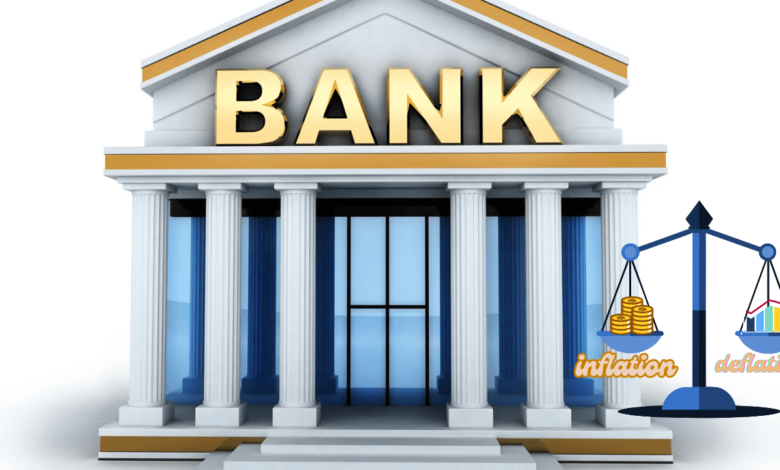Inflation vs. Deflation: How Central Banks Are Shaping the Global Economy

Inflation and deflation are powerful economic forces that central banks constantly strive to balance. While inflation reflects rising prices and often signals economic growth, deflation—marked by falling prices—can indicate stagnation or contraction. Mismanagement of either can have profound consequences for economies, businesses and individuals. In this detailed study, we will examine how central banks such as the Federal Reserve (Fed) and the European Central Bank (ECB) navigate these forces, shaping the global economic landscape.
Understanding inflation and deflation
Inflation: A by-product of growth
Inflation is the rate at which the general level of prices of goods and services rises, eroding the purchasing power of money. While moderate inflation is considered healthy, an indicator of a growing economy, excessive inflation can destabilize markets and undermine consumer confidence.
The main drivers of inflation include:
Demand Pull Inflation: Occurs when aggregate demand exceeds supply, often due to an economic boom or stimulus measures.
Cost-push inflation: occurs when rising production costs (eg labor or raw materials) drive up prices.
Built-in Inflation: Occurs when workers demand higher wages to keep up with rising prices, keeping wage-price increases.
For example, the US faced inflationary pressures after the pandemic as massive fiscal stimulus, supply chain disruptions and consumer demand collided. At its peak in mid-2022, US inflation reached 9.1%, prompting the Fed to intervene aggressively with interest rate hikes.
Deflation: A Hidden Threat
Inflation, on the other hand, refers to a continuous decline in the general price level. While low prices may seem beneficial to consumers, inflation often signals weak demand, reduced investment and shrinking economic output.
The main causes of inflation include:
Decrease in demand: An economic slowdown that leads to a decrease in consumer spending and business investment.
Overcapacity: Excess supply in markets causes prices to fall.
Technological progress: Productivity gains are achieved by lowering production costs and prices (eg, the tech industry).
Japan’s “lost decade” exemplifies the dangers of deflation, where persistent price declines in the 1990s stunted economic growth despite fiscal and monetary interventions.
Role of Central Banks
Central banks act as guardians of economic stability, using monetary policy to manage inflation and deflation. Their primary tools include:
Adjustment of interest rate
Central banks raise or lower interest rates to influence borrowing, spending, and investment:
Control of Inflation: High interest rates inhibit borrowing and spending, reducing demand-driven inflation.
Deflation Control: Low interest rates stimulate borrowing and investment, increasing demand.
For example, the Fed has raised rates from near zero in 2022 to 5% by 2024 to rein in inflation, while the ECB has kept rates more moderate, which is accompanied by economic fragility in Europe. balances the concerns of
Some softness (QE) over hardness (QT)
QE: involves the purchase of financial assets to inject liquidity into the economy, a strategy used during periods of inflation or recession.
QT: Involves reducing the sale or reinvestment of assets to eliminate liquidity and prevent inflation.
Both the Fed and the ECB used large-scale QE during the COVID-19 pandemic to prevent economic collapse. In contrast, 2024 sees QT as an important tool to combat inflation.
Forward guidance
Central banks also influence expectations by signaling future policy directions. For example, the Fed’s continued messaging about keeping rates high through 2024 reassures markets of its commitment to fighting inflation.
Effects on the global economy
Central bank policies affect all economies, influencing investment, trade and consumer behavior.
1. Investment
During inflation: Commodities, real estate, and inflation-linked bonds often perform well. Equities can suffer if companies face rising costs.
During Deflation: Government bonds and cash appeal as safe-haven assets, while equities and real estate may fall due to lower income and asset values.
2. Trade and exchange rates
Higher interest rates in the US have strengthened the dollar, making US exports more expensive and increasing trade imbalances. In contrast, weaker currencies in Europe have boosted exports but complicated energy imports, particularly from dollar-denominated markets.
3. Consumer Behavior
Inflation prompts consumers to spend more quickly before prices rise further, increasing short-run demand.
Inflation causes delays in purchases, anticipation of further price cuts, slowing economic activity.
| Key Metric | United States | Eurozone |
|---|---|---|
| Inflation Rate (Oct 2024) | 3.2% (moderating) | 2.1% (near target) |
| Interest Rates | 5.25%-5.50% | 4.0%-4.25% |
| Economic Growth (2024 Q3) | 1.9% | 0.6% |
Preparing for future challenges
Both inflation and deflation require careful management, not only by policymakers but also by businesses and consumers.
For business
Adopt technology to improve efficiency and reduce costs during periods of inflation.
Develop innovative products and value-based services to sustain demand during inflation.
For investors
Diversify portfolios (eg, commodities, TIPS) to protect against inflation.
Hold cash and government bonds during periods of inflation for stability.
For consumers
Minimize high-interest debt during inflation.
Take advantage of inflation to save and invest wisely.
lnflation and inflation are two of the most important challenges for global economies. Central banks, particularly the Fed and the ECB, are tasked with finding that delicate balance that ensures price stability while promoting sustainable growth. As 2024 progresses, their actions will continue to shape financial markets, consumer confidence and the economic momentum of nations.
By staying informed and proactive, businesses, investors and individuals can navigate these economic waves with flexibility and foresight.




